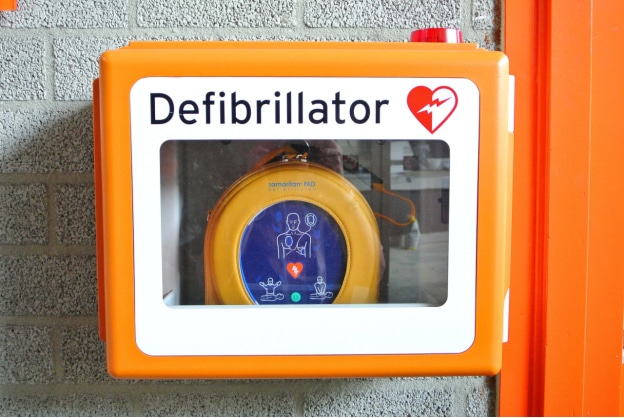CPR classes can train and certify you in the important steps of performing cardiopulmonary resuscitation. But did you know that these online courses can also teach you how to use a defibrillator? These small devices (AEDs are the most common) send electrical impulses to essentially reset the heart for someone experiencing cardiac arrest.
In tandem with CPR, the use of an AED can dramatically improve the survival rate of a cardiac arrest victim. In fact, according to data, a victim’s survival rate drops by about 7 to 10 percent for each minute that passes without CPR or the use of a defibrillator. In short, these small medical devices save lives.
But how exactly do they work? Many bystanders may hesitate to use one in an emergency situation out of fear that they’ll use it incorrectly. Defibrillators, to the surprise of many, are relatively simple to operate. Most AEDs even come with automated voice instructions to walk you through the steps. Here, we take a closer look at defibrillators to understand how they work and how to effectively use one in a medical emergency.
What is an Automated External Defibrillator (AED)?
An automated external defibrillator, also known as an AED, is a small medical device designed to help victims of cardiac arrest. This is the most common type of defibrillator and can be found on walls in schools, hospitals, and office buildings across the country. These small electrical devices include adhesive pads that are placed on the body of the victim. These pads send the electrical impulse from the AED to the victim’s heart.
Types of Defibrillators
Primarily there are three different types of defibrillators: automated external defibrillators (AEDs), implantable cardioverter defibrillators (ICDs), and wearable cardioverter defibrillators (WCDs). Here’s a closer look at each one:
-
Automated external defibrillator (AED).
These small devices are commonly seen in schools and hospitals and are designed to be used by bystanders to assist a victim undergoing cardiac arrest.
-
Implantable cardioverter defibrillators (ICD)
For those at high risk for arrhythmia, which is an irregular heartbeat that can have many causes, these defibrillators are surgically implanted in individuals.
-
Wearable cardioverter defibrillator (WCD).
Similar to ICDs, these defibrillators are for those at risk from arrhythmia; however, the key difference here is that these are worn on the body instead of being surgically implanted.
How Do Defibrillators Work?
AEDs are the only type of defibrillator that can be manually operated by a bystander, which is why they will be the focus of this section. With both verbal and written step-by-step instructions, AEDs are designed so that even a bystander with little to no medical knowledge could safely operate one.
Once applied to the body, the AED uses sensory pads to detect the victim’s heart rate. If an irregular heart rhythm is detected, the AED alerts the user and provides the option to send an electrical shock. This shock serves to reset the heart, setting it back to a normal rhythm.
How To Use An AED
AEDs and other defibrillators are designed so that almost anyone can properly use them in the event of an emergency. Every year, over 350,000 cardiac arrests occur outside of a hospital each year, which is why it’s critical that these medical devices are both available and easy to use so bystanders will be encouraged to step in and take action. Online CPR/AED classes are the most thorough way to learn how to use an AED. These are some of the essential steps you’ll learn as part of this certification:
- Assess the scene of the emergency. Make sure it’s safe before responding to the victim and have someone call 911.
- Position the victim so that they are lying flat on their back.
- Turn on the AED and read or listen to the automated instructions.
- Remove any clothing from their chest—it’s important that the AED pads are attached to bare and dry skin.
- Carefully apply the AED pads to the victim’s chest.
- Make sure that no one is making physical contact with the victim—this includes yourself.
- Press the “analyze” button on the AED, which detects whether or not the victim is experiencing heart arrhythmia.
- Following the analysis, the AED may or may not recommend that you deliver a shock to the victim. If so, press the “shock” button.
- In addition to using the AED, you should then perform CPR. Cycle between chest compressions and rescue breaths until medical assistance arrives.
Conclusion – How Do Defibrillators Work?
Defibrillators, such as AEDs, may seem complex but are actually designed so that almost anyone can use them in the event of an emergency. If someone is experiencing cardiac arrest, CPR and the use of an AED could be the difference between life and death. If you’re a bystander at such a scene, don’t hesitate to take action. Take action today by earning your online CPR/AED certification! You’ll receive the knowledge, skills, and confidence to make a difference.






